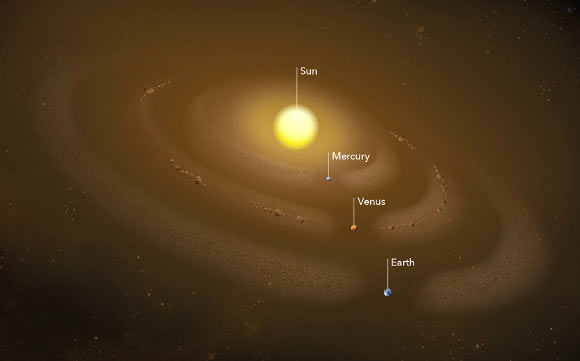Astronomers Detect Circumsolar Dust Ring near Mercury’s Orbit | Astronomy – Sci-News.com
A team of astronomers from the U.S. Naval Research Laboratory in Washington, DC, and the University of Colorado, Boulder, has found evidence for a fine haze of cosmic dust over Mercury’s orbit, forming a ring some 9.3 million miles (15 million km) wide.

In this illustration, several dust rings circle the Sun. These rings form when planets’ gravities tug dust grains into orbit around the Sun. Image credit: NASA’s Goddard Space Flight Center / Mary Pat Hrybyk-Keith.
“Scientists never considered that a dust ring might exist along Mercury’s orbit, which is maybe why it’s gone undetected until now,” said lead author Dr. Guillermo Stenborg, from the Space Science Division at the Naval Research Laboratory.
“They thought that Mercury, unlike Earth or Venus, is too small and too close to the Sun to capture a ring. They expected that the solar wind and magnetic forces from the Sun would blow any excess dust at Mercury’s orbit away.”
“We found it by chance,” he added.
Ironically, Dr. Stenborg and his colleagues, Dr. Russell Howard and Dr. Johnathan Stauffer, stumbled upon the dust ring while searching for evidence of a dust-free region close to the Sun.
At some distance from the Sun, according to a decades-old prediction, the star’s mighty heat should vaporize dust, sweeping clean an entire stretch of space. Knowing where this boundary is can tell scientists about the composition of the dust itself, and hint at how planets formed in the young Solar System.
So far, no evidence has been found of dust-free space, but that’s partly because it would be difficult to detect from Earth.
The researchers figured they could work around this problem by building a model based on pictures of interplanetary space from NASA’s Solar and Terrestrial Relations Observatory (STEREO).
Ultimately, they wanted to test their new model in preparation for NASA’s Parker Solar Probe, which is currently flying a highly elliptic orbit around the Sun.
They wanted to apply their technique to the images Parker will send back to Earth and see how dust near the Sun behaves.
Two kinds of light show up in STEREO images: light from the Sun’s corona and light reflected off all the dust floating through space. The sunlight reflected off this dust, which slowly orbits the Sun, is about 100 times brighter than coronal light.
“We’re not really dust people. The dust close to the Sun just shows up in our observations, and generally, we have thrown it away,” Dr. Howard said.
Mercury’s dust ring was a lucky find, a side discovery the astronomers made while they were working on their model.
When they used their new technique on the STEREO images, they noticed a pattern of enhanced brightness along Mercury’s orbit — more dust, that is — in the light they’d otherwise planned to discard.
“It wasn’t an isolated thing,” Dr. Howard said.
“All around the Sun, regardless of the spacecraft’s position, we could see the same 5% increase in dust brightness, or density. That said something was there, and it’s something that extends all around the Sun.”
The discovery is described in a paper in the Astrophysical Journal.
_____
Guillermo Stenborg et al. 2019. Evidence for a Circumsolar Dust Ring near Mercury’s Orbit. ApJ 868, 74; doi: 10.3847/1538-4357/aae6cb





